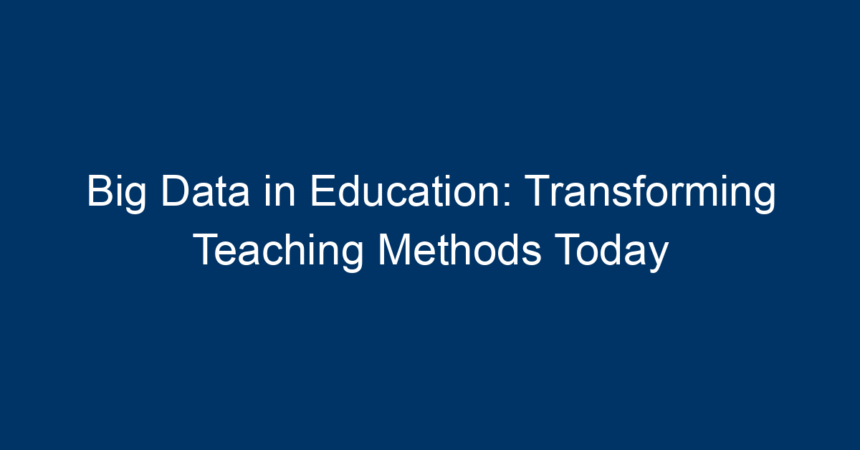In the digital age, information is not just abundant; it’s transforming every sector, including education. The increasing presence of big data in education is revolutionizing the traditional teaching methods and enhancing the learning experience. By analyzing vast amounts of data from various sources, educators can glean insights into student performance, learning styles, and even predict future trends in education. This article delves into how big data is reshaping educational strategies and the classroom environment, providing actionable insights for administrators, teachers, and policymakers.
Understanding Big Data in Education
Big data refers to the immense volume of data collected from various sources that is too complex for traditional data-processing software to handle. In the context of education, big data encompasses:
- Student Performance Data: Grades, attendance records, assessment scores.
- Learning Management Systems (LMS): Interaction data from platforms like Moodle or Blackboard.
- Social Media: Insights from student engagement and discussions on platforms such as Twitter or Facebook.
- Online Courses: Data from MOOCs (Massive Open Online Courses) and other online training programs.
These data points can be analyzed to identify patterns, trends, and actionable insights that can lead to improved teaching and learning outcomes.
The Benefits of Big Data in Education
Enhanced Student Performance Tracking
One of the most significant advantages of big data in education is the ability to closely track student performance. Educators can analyze trends over time, identify at-risk students, and tailor interventions to support individual learning needs. For instance, by evaluating assessment scores in real-time, instructors can pinpoint concepts that students struggle with and modify their teaching strategies accordingly.
Personalized Learning Experiences
Every student has a unique learning style. Big data in education allows for personalized learning experiences tailored to individual needs. By analyzing performance data and engagement levels, educators can create customized learning pathways that accommodate different learning paces. For instance, data can indicate which students excel in visual learning and which benefit more from interactive methods.
Predictive Analytics for Early Intervention
Applications of predictive analytics in education can identify potential dropouts or students who may struggle in the future. By leveraging big data, educators can deploy early intervention strategies, thereby improving student retention rates and success. Predictive models can analyze historical data, allowing the education system to act before a student’s performance declines significantly.
Efficient Resource Allocation
Educational institutions often face budget constraints, and big data can assist in making informed decisions regarding resource allocation. By analyzing usage data from various programs, schools can determine which resources are effective in improving student outcomes and which are underutilized. This leads to more strategic investments in educational technology and staffing.
Implementing Big Data Solutions in Educational Settings
1. Establishing a Robust Data Infrastructure
To fully leverage the potential of big data, educational institutions must invest in the necessary data infrastructure. This includes reliable software and platforms capable of collecting and analyzing data effectively. A well-integrated Learning Management System (LMS) can serve as a centralized hub for all student interaction data.
2. Training Educators and Administrators
Even the best technology is only as effective as the people using it. Therefore, providing training for educators on big data analytics is crucial. Professional development workshops should focus on how to interpret data, create dashboards, and integrate insights into teaching methods.
3. Ensuring Data Privacy and Security
With the increasing amount of personal data collected, educational institutions must prioritize data privacy and security. Implementing strong data protection measures is essential to maintaining student trust and compliance with regulations. Institutions should adopt transparency guidelines regarding how data is collected, used, and shared.
4. Encouraging Collaborative Learning
Using big data can foster a collaborative learning environment. By analyzing group work interactions, teachers can facilitate peer learning opportunities. Group dynamics can be evaluated to form diverse teams that enhance learning experiences and outcomes.
Challenges of Big Data in Education
Data Overload
While big data offers great insights, the sheer volume of information can be overwhelming. Educators may struggle to extract the most relevant data for decision-making. It’s essential to develop strategies for filtering and interpreting the data to derive actionable insights.
Resistance to Change
Not all educators may embrace data-driven education. Some may feel threatened by relying heavily on data analytics. To overcome this, institutions should involve educators in discussions about the benefits of big data and foster a culture of collaboration and innovation.
Ethical Considerations
The ethical implications of using big data in education necessitate careful consideration. It’s vital to balance data-driven decision-making with ethical practices in data collection and usage. Establishing a clear ethical framework can guide educators in making responsible decisions when it comes to big data.
Real-World Applications of Big Data in Education
1. Adaptive Learning Technologies
Many educational platforms are employing big data to create adaptive learning technologies. These technologies adjust the curriculum based on the student’s performance in real-time, offering tailored challenges that suit their individual needs.
2. Learning Analytics
Institutions are increasingly implementing learning analytics to analyze data on student behavior, such as study habits and late-night homework sessions. This analysis can lead to strategies that promote better learning outcomes, such as adjusted classroom schedules or targeted resources.
3. Curriculum Improvement
Big data can reveal trends in student success across different curricula, providing insights into which programs yield the best results. Educators can use this information to refine curricula, ensuring that they meet the needs of students effectively.
Conclusion: Actionable Insights for Educators and Administrators
The integration of big data in education is not merely a trend; it is a fundamental shift in how educators teach and how students learn. To harness its power effectively, educational institutions must:
- Invest in the right data infrastructure.
- Provide continuous training for staff on data analysis.
- Prioritize ethical standards and data privacy.
- Foster collaboration among educators and students.
As we move forward into an increasingly data-driven future, the focus should remain on utilizing big data to create more inclusive, engaging, and effective learning environments. By embracing these actionable insights, educators and administrators can ensure they are at the forefront of educational innovation, ultimately leading to improved student outcomes and a brighter educational landscape.




